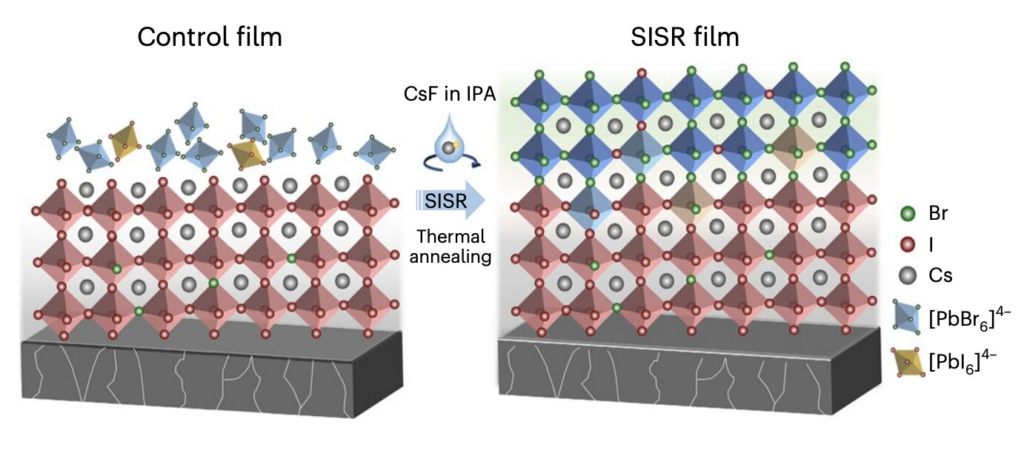Improving the efficiency and carrier lifetimes of all-inorganic perovskite solar cells is a complex challenge, but here are some strategies that researchers have explored:
- Surface passivation: All-inorganic perovskite solar cells have a high density of surface defects, which can lead to carrier recombination and reduce the efficiency of the device. Surface passivation techniques, such as using a thin layer of insulating material like aluminum oxide, can reduce the number of surface defects and improve the carrier’s lifetime.
- Doping: Doping the perovskite material with elements like copper, nickel or cobalt can improve the efficiency of the device by increasing the conductivity of the material and reducing the number of traps.
- Bandgap engineering: The bandgap of the perovskite material can be engineered by changing the composition of the material. This can improve the efficiency of the device by better matching the solar spectrum and reducing the energy lost as heat.
- Interface engineering: The interface between the perovskite material and the other layers of the device can also be optimized to reduce the number of defects and improve charge carrier extraction.
- Device architecture: The design of the device can also impact its efficiency and carrier lifetimes. Researchers have explored different device architectures, such as tandem devices, to improve the efficiency of the device.
It’s worth noting that all-inorganic perovskite solar cells are a relatively new technology, and there is still much research to be done to fully understand and optimize their performance.
Increase your understanding of perovskite:
Surface Reconstruction of Perovskite Films Boosts Solar Cell Efficiency to 21%

Credit: Chu et al, Nature Energy (2023).
DOI: 10.1038/s41560-023-01220-z
A team of researchers led by Xinbo Chu from the Chinese Academy of Sciences has developed a technique to improve the performance and stability of perovskite solar cells (PSCs). In a paper published in Nature Energy, they describe how they used a surface in situ reconstruction(SISR) method to modify the crystal structure and chemical composition of the perovskite film, resulting in long carrier lifetimes and high open-circuit voltages.
Perovskite materials have attracted much attention in the field of photovoltaics due to their unique properties, such as high absorption coefficients, low exciton binding energies, and tunable band gaps. However, the practical application of PSCs has been hindered by their susceptibility to moisture, heat, and light, which can cause degradation and hysteresis effects. In addition, the interface between the perovskite and the charge transport layers is critical for the charge extraction and injection processes but often suffers from energy barriers, defects, and traps.
To address these challenges, the researchers developed a surface in situ reconstruction method based on a mixed-halide perovskite film of formamidinium lead iodide (FAPbI3) and cesium lead bromide (CsPbBr3). The key idea is to selectively remove the iodide anions on the surface of the FAPbI3 grains by exposing them to a bromide-containing solution, which induces the migration of the iodide vacancies and the formation of CsPbI3 domains. The resulting film has a graded halide composition and a smooth surface, with fewer defects and traps.
The researchers then fabricated PSCs using this reconstructed perovskite film and a series of optimized device architectures. The best-performing PSC showed a power conversion efficiency (PCE) of 21.0%, a fill factor (FF) of 80.7%, a short-circuit current density (Jsc) of 24.7 mA cm-2 and an open-circuit voltage (Voc) of 1.24 V. The PCE of 21.0% is among the highest reported for PSCs based on inorganic perovskites, and the FF and Voc also record values for this type of PSCs.
The researchers also investigated the carrier dynamics and hysteresis behavior of the PSCs by various spectroscopic and electrical measurements. They found that the reconstructed perovskite film exhibited longer carrier lifetimes and diffusion lengths, which are attributed to the reduced surface defects and the better passivation of the grain boundaries. Moreover, the PSCs showed negligible hysteresis effects and good stability under ambient conditions, indicating the effectiveness of the surface reconstruction method in improving the device’s performance and reliability.
In summary, the surface in situ reconstruction of inorganic perovskite films enables the fabrication of PSCs with high efficiency, stability, and reproducibility. The optimized perovskite film has a graded halide composition and a smooth surface, which reduce surface defects and traps and enhance charge transport and collection. The PSCs based on the reconstructed perovskite film exhibit record values of PCE, FF, and Voc, as well as long carrier lifetimes and minimal hysteresis effects. These results pave the way for the practical application of PSCs in renewable energy and other fields.
References:
Chu, X., Ye, Q., Wang, Z. et al. Surface in situ reconstruction of inorganic perovskite films enabling long carrier lifetimes and solar cells with 21% efficiency. Nat Energy (2023). https://doi.org/10.1038/s41560-023-01220-z
https://techxplore.com/news/2023-04-strategy-efficiency-carrier-lifetimes-all-inorganic.html














